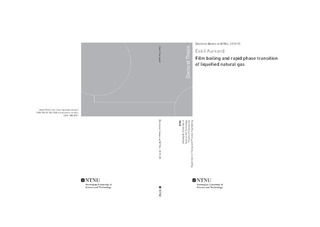| dc.contributor.advisor | Müller, Bernhard | |
| dc.contributor.advisor | Hammer, Morten | |
| dc.contributor.advisor | Tollak, Svend | |
| dc.contributor.advisor | Ytrehus, Tor | |
| dc.contributor.author | Aursand, Eskil | |
| dc.date.accessioned | 2019-04-05T11:30:45Z | |
| dc.date.available | 2019-04-05T11:30:45Z | |
| dc.date.issued | 2019 | |
| dc.identifier.isbn | 978-82-326-3745-4 | |
| dc.identifier.issn | 1503-8181 | |
| dc.identifier.uri | http://hdl.handle.net/11250/2593515 | |
| dc.description.abstract | When liquefied natural gas (LNG) is spilled onto water there is a possibility that explosive rapid phase transition (RPT) events occur. According to experiments, these vapor explosions are highly unpredictable, with yields up to several kilograms of TNT equivalent. The leading theory of RPT claims that triggering occurs due to a sudden and rapid chain of events involving film-boiling collapse, liquid superheating, rapid nucleation and explosive expansion. Still, after over four decades of research on the topic, it appears that there is no reliable and accepted method for quantitative LNG RPT risk-assessment. The main goal of the present thesis is to remedy this issue through theoretical means. According to the leading theory of RPT, prediction of the triggering event necessitates modelling of two properties: the Leidenfrost temperature and the superheat limit temperature, both of which were investigated herein.
The Leidenfrost temperature is by definition the surface temperature below which film-boiling collapse occurs. Therefore, it is necessary to understand film boiling and its stability. While much work has been done in the past on modelling the stability of thin liquid films with the long-wave approximation, these models are not directly applicable to film boiling. The equations describing a vapor film trapped between two dense phases of extremely different temperatures turn out to be different in subtle but important ways. In this project a new model for vapor-film dynamics has been developed within the long-wave approximation methodology. This model crucially involves a coupling to non-equilibrium evaporation models from kinetic theory, which allows for the inclusion of the thermocapillary effect at the evaporating interface. Based on stability analysis of this model, a novel and promising prediction method for the Leidenfrost temperature has been discovered. The method carries with it the surprising theoretical implication that film-boiling collapse occurs when the thermocapillary instability overpowers vapor-thrust stabilization. However, further experimental investigations of the Leidenfrost temperature is needed in order to draw strong conclusions regarding its validity.
The superheat limit may be estimated within the framework of classical nucleation theory (CNT). These predictions have been compared with a wide array of relevant experimental data on hydrocarbons, both for pure fluids and binary mixtures. The performance of the CNT model was deemed satisfactory, and thus, no further efforts to improve superheat limit modelling have been made in this project.
Finally, a framework for the prediction of RPT risk and consequence during LNG boil-off has been developed. This framework demonstrates how models for the Leidenfrost temperature and the superheat limit temperature as functions of LNG mixture composition may be combined with classical thermodynamics in order to predict when (and if) the conditions for RPT triggering may be met. Additionally, it has been shown how the predicted LNG composition at the time of triggering may be used to estimate the worst case explosive pressure and energy yield through the use of a simplified thermodynamic model. While quite idealized, this framework represents an important step towards practical risk assessment and mitigation for LNG rapid phase transition. The thesis concludes with a series of suggestions on how the framework may be further improved. | nb_NO |
| dc.language.iso | eng | nb_NO |
| dc.publisher | NTNU | nb_NO |
| dc.relation.ispartofseries | Doctoral theses at NTNU;2019:70 | |
| dc.relation.haspart | Paper A: Aursand, Eskil; Davis, Stephen H.; Ytrehus, Tor. Thermocapillary instability as a mechanism for film boiling collapse. Journal of Fluid Mechanics 2018 ;Volum 852. s. 283-312
https://doi.org/10.1017/jfm.2018.545 | nb_NO |
| dc.relation.haspart | Paper B: Aursand, Eskil. Inclination dependence of planar film boiling stability. International Journal of Multiphase Flow 2018 ;Volum 106. s. 243-253
https://doi.org/10.1016/j.ijmultiphaseflow.2018.05.010 | nb_NO |
| dc.relation.haspart | Paper C: Aursand, Eskil; Davis, Stephen H.. Inclined film boiling: Film stability and heat transfer. International Journal of Multiphase Flow 2019 ;Volum 111. s. 175-187
https://doi.org/10.1016/j.ijmultiphaseflow.2018.11.017 | nb_NO |
| dc.relation.haspart | Paper D: Aursand, Eskil; Hammer, Morten. Predicting triggering and consequence of delayed LNG RPT. Journal of Loss Prevention in the Process Industries 2018 ;Volum 55. s. 124-133
https://doi.org/10.1016/j.jlp.2018.06.001 | nb_NO |
| dc.relation.haspart | Paper E:
Aursand, Eskil; Ytrehus, Tor.
Comparison of kinetic theory evaporation models for liquid thin-films | nb_NO |
| dc.relation.haspart | Paper F: Aursand, Peder; Gjennestad, Magnus Aashammer; Aursand, Eskil; Hammer, Morten; Wilhelmsen, Øivind.
The spinodal of single- and multi-component fluids and its role in the development of modern equations of state. Fluid Phase Equilibria 2016 ;Volum 436. s. 98-112
https://doi.org/10.1016/j.fluid.2016.12.018 | nb_NO |
| dc.title | Film boiling and rapid phase transition of liquefied natural gas | nb_NO |
| dc.type | Doctoral thesis | nb_NO |
| dc.subject.nsi | VDP::Technology: 500::Environmental engineering: 610 | nb_NO |

